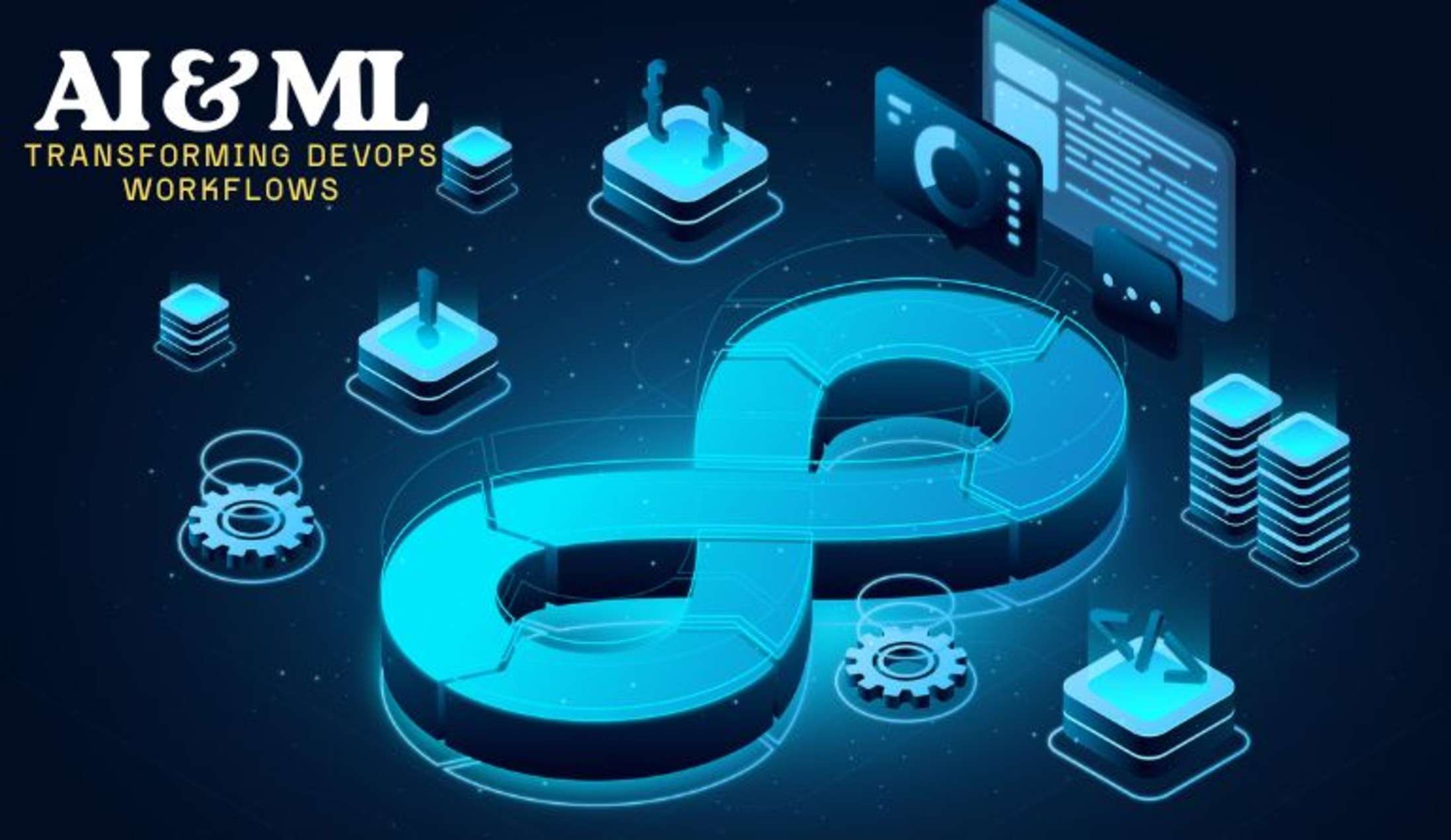
The rapid evolution of Artificial Intelligence (AI) and Machine Learning (ML) is revolutionizing DevOps practices. No longer just buzzwords, these technologies are fundamentally shifting how organizations build, deploy, manage, and monitor applications. Here’s a detailed look at how AI and ML are integrated into DevOps workflows and monitoring, driving efficiency, reliability, and business value.
Hire a DevOps Expert
The AI/ML Impact on DevOps
Intelligent Automation of Workflows
AI-powered automation reduces manual intervention throughout the DevOps lifecycle. Tasks such as code integration, testing, deployment, and infrastructure provisioning can be triggered, optimized, and resolved with the help of ML models. These systems learn from historical data, allowing for:
Predictive Workflow Automation
AI and ML models analyze historical deployment, testing, and operational data to predict potential bottlenecks or failures in the DevOps pipeline. Instead of waiting for a failure to occur, these models proactively recommend or trigger corrective actions, such as reallocating tasks, optimizing deployment schedules, or increasing testing coverage. This reduces downtime and improves the speed and reliability of software delivery.
Proactive Resource Allocation
ML algorithms learn from usage patterns and system loads to dynamically allocate or de-allocate computing resources (e.g., servers, containers, or cloud instances). This ensures infrastructure is optimally utilized, avoiding over-provisioning and minimizing costs while maintaining performance during peak demand.
Self-Healing Systems
AI-powered systems can detect common failure patterns and automatically initiate remediation steps—like restarting failed services, rolling back problematic code changes, or reallocating traffic. This minimizes the need for human intervention and reduces mean time to recovery (MTTR).
Advanced Monitoring and Observability
Traditional monitoring often means reactive alerts on performance issues. AI/ML transform monitoring into a proactive and predictive activity:
Anomaly Detection
Traditional rule-based alerts are often static and can miss new or unexpected problems. ML-powered anomaly detection continuously learns baseline performance metrics and user behavior, identifying deviations that may indicate emerging issues. This includes subtle changes in response times, error rates, or unusual traffic spikes, enabling teams to address problems before users are affected.
Intelligent Alerts
AI algorithms filter and prioritize alerts based on their severity, potential impact, and historical incident outcomes. This reduces alert fatigue, ensuring that engineers focus on the most critical alerts and reducing noise from false positives.
Root Cause Analysis
ML models automatically correlate data from diverse sources such as logs, system metrics, traces, and configuration changes to quickly identify the underlying cause of failures. By narrowing down the root cause, teams can resolve incidents faster without lengthy manual investigations.
Smarter Testing and Quality Assurance
AI/ML optimize testing pipelines by:
Test Case Generation
AI can analyze code changes and previous test results to generate relevant test cases automatically. It prioritizes tests that have the highest chance of detecting bugs influenced by recent changes, reducing testing cycles while maintaining coverage.
Automated Bug Detection
Machine learning models trained on historical bug reports and code patterns can predict which parts of the codebase are more likely to contain defects. This allows QA teams to focus their efforts effectively, catching defects earlier in the development process.
Release Risk Assessment
AI evaluates the risk of a new software release by analyzing historical deployment data, bug trends, and system behaviors. It provides predictions on the likelihood of release failures or performance regressions, supporting informed decision-making on whether to proceed or delay deployments.
Adaptive Security in DevSecOps
Embedding AI/ML into DevOps workflows accelerates security (DevSecOps):
Threat Intelligence
ML systems continuously analyze threat data from multiple sources, including network traffic, code repositories, and vulnerability databases, to identify and classify new security risks. This accelerates vulnerability scanning and patch prioritization, ensuring that security gaps are addressed promptly.
Dynamic Policy Enforcement
AI models adapt security policies in real time based on detected threats and evolving compliance requirements. For example, access controls and firewall rules can be automatically tightened if suspicious activity is detected, providing an extra layer of defense without manual intervention.
Incident Response Automation
When security incidents occur, AI-driven tools orchestrate automated workflows that contain and mitigate threats. This includes isolating affected systems, alerting security teams, and even initiating forensic data collection to speed up investigations and reduce damage.
AIOps and MLOps: The Future of Operations
AIOps
Artificial Intelligence for IT Operations uses big data, machine learning, and analytics to automate and enhance IT management tasks. AIOps platforms unify event correlation, anomaly detection, and automation to improve service availability, reduce operational costs, and speed incident resolution. This leads to more resilient and efficient operations.
MLOps
MLOps applies DevOps best practices to the lifecycle of AI/ML models, enabling organizations to deploy, monitor, and retrain models in production reliably at scale. This approach ensures that AI/ML models driving automation and monitoring remain accurate, up-to-date, and compliant as business needs evolve.
Real-World Examples
Predictive Maintenance
Companies that run critical infrastructure—such as banks or e-commerce platforms—use AI/ML models to analyze system logs, hardware telemetry, and application performance trends to forecast when hardware components (like disks or memory) are likely to fail. By anticipating these failures, IT teams can schedule maintenance during low-traffic periods, avoiding disruptive downtime and expensive emergency fixes.
Dynamic Load Balancing
Enterprises with high-traffic applications employ ML algorithms to monitor real-time application usage and predict surges in user demand. These algorithms automatically reroute network traffic and allocate additional computing resources, preventing overload on any single server or service. This ensures seamless user experiences even during peak loads.
Fraud Detection in CI/CD Pipelines
Financial institutions integrate ML models into their DevOps pipelines to scan application deployments for suspicious code changes or unusual access patterns. If a potential fraud indicator—such as an unauthorized code modification or anomalous login—is detected, the system immediately flags the deployment and can halt it, ensuring security is never compromised during rapid releases.
Proactive Incident Response
Major cloud providers and SaaS vendors deploy AIOps platforms that monitor millions of events per second. Using ML, they can group related alerts, suppress false positives, and trigger automated scripts that fix issues (such as restarting crashed services or rolling back faulty updates) before customers even notice a problem.
Optimized Cost Management
Organizations leveraging cloud infrastructure use ML-based analytics to understand usage trends, predict future resource requirements, and recommend rightsizing or shutdowns of underutilized assets. This not only optimizes costs but also supports sustainability initiatives by reducing excess resource consumption.
Intelligent Auto-Remediation
E-commerce companies often integrate AI into their incident management platforms. Suppose a checkout system throws an error due to a database connection timeout. The AI detects the pattern, cross-references with historical incident data, and initiates a known fix—like restarting the database service or switching to a replica. Meanwhile, it notifies the DevOps team and provides root cause insights for further analysis.
Key Benefits
- Faster Detection and Resolution of incidents and bugs.
- Reduced Manual Effort and increased productivity for development and operations teams.
- Enhanced Application Reliability through predictive analytics and self-healing systems.
- Improved Security with adaptive and automated threat response.
- Better Resource Utilization and cost savings via dynamic scaling and automation.
Getting Started: Best Practices for Implementing AI and ML in DevOps
Define Clear Objectives
Start with well-defined, measurable goals for what you want AI/ML to achieve within your DevOps workflows. Be specific about the problems you want to solve—such as reducing deployment failures, accelerating incident resolution, or improving resource utilization. Clear objectives help you focus efforts and measure success accurately.
Start Small and Iterate
Begin AI/ML implementation with pilot projects in specific areas that stand to gain the most—such as anomaly detection in monitoring or automated testing. Use learnings from these pilots to refine models and processes before scaling AI adoption more broadly across your DevOps pipelines. Incremental rollout reduces risk and improves outcomes.
Ensure High-Quality and Secure Data
AI and ML models rely heavily on the quality and security of the underlying data. Establish strong data governance policies to validate, clean, and secure your operational data. Protect sensitive data, especially when using public or third-party AI/ML platforms, to avoid leaks and compliance issues.
Involve the Right Stakeholders
Engage cross-functional teams including developers, operations, data scientists, security experts, and business leaders. Their insights help identify relevant AI use cases, evaluate model outputs, and establish accountability. This collaborative approach fosters trust and maximizes the impact of AI in your DevOps processes.
Incorporate Human Oversight
Despite automation, maintain human review and decision-making for critical DevOps actions influenced by AI. Humans should monitor AI recommendations, approve significant changes, and intervene when models behave unexpectedly. This preserves control and ensures responsible AI usage.
Emphasize Transparency and Accountability
Make AI and ML decision-making processes explainable to stakeholders. Document how models are trained, what data is used, and their limitations. Maintain logs and audit trails of AI-driven decisions to facilitate troubleshooting, compliance, and continuous improvement.
Automate Workflows with Repeatable and Verifiable Deployments
Use Infrastructure as Code (IaC) and automated pipelines to enable consistent, repeatable deployments of AI components as well as application code. Test AI/ML integration thoroughly to catch subtle bugs and performance regressions early. Ensure deployment metrics align with DevOps standards like those from DORA.
Implement Continuous Monitoring and Improvement
AI models and automation workflows require ongoing monitoring to detect drift, evaluate performance against KPIs, and adapt to evolving environments. Establish feedback loops to retrain models and update automation rules routinely for sustained effectiveness.
Prioritize Security and Compliance
Embed AI-driven security controls in your DevOps pipelines, from automated vulnerability scanning to real-time threat detection. Regularly assess AI models and data practices for compliance with regulations and internal policies to mitigate risks.
Invest in Skills and Culture
Equip your teams with expertise in AI, ML, data science, and DevOps practices. Promote a culture of collaboration, experimentation, and continuous learning to maximize AI adoption success. Facilitate knowledge sharing and hands-on experience through training and pilot projects.
These best practices provide a solid foundation for organizations looking to successfully integrate AI and ML into their DevOps workflows to achieve automation, predictive operations, and enhanced reliability. If you want, I can help you further tailor these practices into a comprehensive implementation guide for your company.
Conclusion
AI and Machine Learning are redefining the DevOps landscape by enabling smarter automation, proactive monitoring, and adaptive security. Their integration empowers organizations to accelerate software delivery, improve system reliability, and reduce operational costs. While the journey to AI-driven DevOps requires careful planning, quality data, and skilled collaboration, the benefits far outweigh the challenges. By adopting best practices and embracing AI and ML technologies, IT companies can future-proof their DevOps processes and deliver superior value in today’s fast-paced digital world.
Embracing AI and ML is no longer just an option—it is a strategic imperative for any organization aiming to stay competitive in the evolving technology ecosystem. The future of DevOps is intelligent, predictive, and automated, and those who innovate now will lead tomorrow’s digital transformation.













